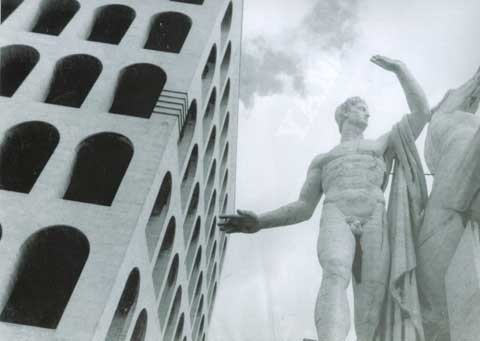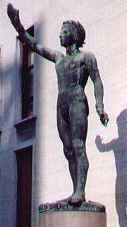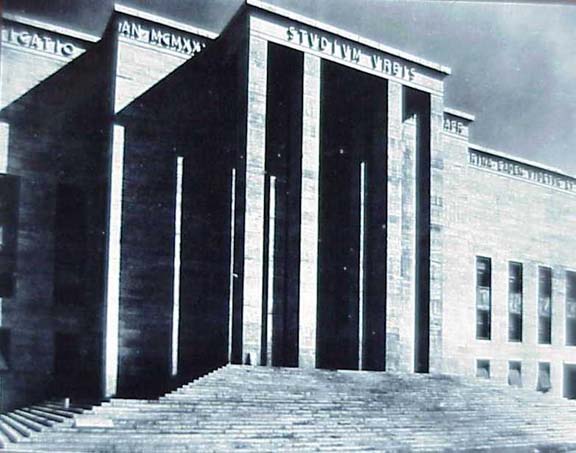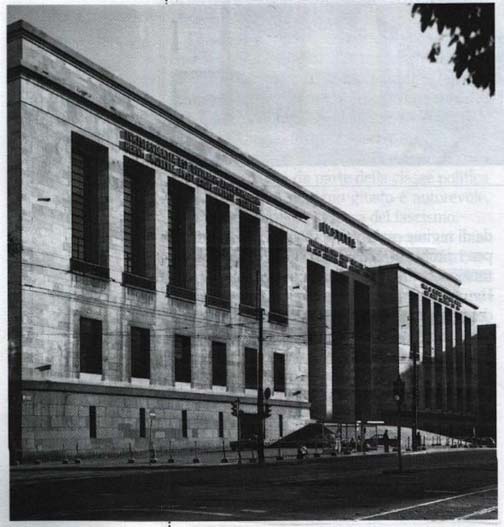| New York Architecture Images- notes | |||||||||||||||||||||||||||||||||||||||||||||||||||||||||||||||||||||||||||||||||
| fascist architecture influences on Philip Johnston | |||||||||||||||||||||||||||||||||||||||||||||||||||||||||||||||||||||||||||||||||
| Click here for Fascist-era architecture in Italy, Germany and England. | |||||||||||||||||||||||||||||||||||||||||||||||||||||||||||||||||||||||||||||||||

In 1936 the Italian government made a
successful application for hosting in Rome the next World Exhibition
which was due in 1941. The Exhibition was soon postponed to 1942 to
celebrate the XXth anniversary of the Fascist regime.
The Fascist regime emphasized the links between the expansion of the Roman Empire and its own aggressive policies and it poured money into redesigning in a spectacular way many areas of the city, mainly to the detriment of medieval or Baroque monuments; for sure the regime had something in common with the ancient Romans: a passion for erecting large buildings. Nevertheless the inscription on Palazzo della Civiltà Italiana (renamed della Civiltà del Lavoro) does not include costruttori (builders) in the list of the attibutes of the Italians. VN POPOLO DI POETI DI ARTISTI DI EROI DI SANTI DI PENSATORI (philosophers) DI SCIENZIATI DI NAVIGATORI DI TRASMIGRATORI (the meaning of this word today is rather obscure, but in the 1930s it was most likely a reference to the first intercontinental flights). The inscription as well as the building were the subject of many jokes: less commendable attributes were added to the list and the building was soon called Colosseo Quadrato (square) and even worse Palazzo del Groviera, after the Swiss cheese gruyère. While the arches of the building are a reminder of the Colosseo arches, the four statues at its corners have many points in common with those in Piazza del Quirinale.
The first building to be completed was aimed at hosting the offices for the Exhibition, and it included a large hall announced from the outside by a high portico (on its top an inscription celebrates the expansion of Rome towards the sea).
While the building had a very neat and modern design the mosaics and the reliefs which embellished it were evocative of Ancient Rome. The black and white mosaics replicated a pattern typical of Caracalla's Baths and the reliefs portrayed ancient monuments (in the image above: the Arch of Titus, Trajan's Column and the Pantheon). Mussolini himself was portrayed as if he were a direct descendant of the Roman consuls and emperors. He had a peculiar way of speaking with his fists pointed against his hips as shown by the position of his left arm; the right arm is raised in the so called saluto fascista which had replaced the traditional shaking of hands. What at the time must have looked very impressive, today appears a flattering description of Mussolini's ability to ride a horse without holding the reins.
Michelangelo Antonioni is an Italian filmmaker who became famous in the early 1960s by a series of movies which depicted the difficulty of living, not because of material conditions or negative events, but because of existential anxieties. He shot several scenes of The Eclipse (1962) among the EUR buildings. The empty porches, the isolated statues, the unusually shaped buildings provided him with a not humanly scaled background which highlighted the feeling his characters had of living in an alien world.
The gigantic stela dedicated to Guglielmo Marconi is a clear reference to the obelisks of Rome, but it does not have the grace of the originals. The Exhibition never took place because of WWII and the few buildings which had been completed were occupied by families who had lost their homes because of war events. In 1951, when the post war emergency was gradually receding, the Italian government decided to complete the quarter by relocating public offices and by inviting companies to build their headquarters in the new quarter. The quarter was renamed Quartiere Europa retaining to some extent its original name and the streets and buildings were in some cases renamed too in order to cancel references to the past regime. The assignment to Rome of the 1960 Olympic Games gave a new impulse to the completion of the monumental parts of EUR including the stela to Marconi.
The EUR hosts several museums which are scarcely visited by tourists. One of them (Museo Pigorini) includes most of the collection of African, Chinese and American handicrafts gathered in Collegio Romano by the Jesuit Athanasius Kircher in the XVIIth century. Another interesting museum (Museo della Civiltà Romana) includes a reconstruction (scale 1:250) of the City of Rome in the IVth century. Also the materials used in the EUR buildings remind visitors of Ancient Rome: for the columns of the building shown in the picture the architects used a green stone resembling cipollino, a marble very much in fashion in the IInd century (see the cipollino columns of the Temple of Annia Faustina - S. Lorenzo in Miranda).
The low dome of Palazzo dei Congressi is evocative of the Pantheon and the reference is more evident when the building is seen from the other side (in the image used as a background for this page). The photo shown above was taken on a summer Sunday when this part of EUR is almost deserted (if you wish to see the monuments of Rome on a summer Sunday morning click here).
This palace is decorated with vaguely Renaissance reliefs portraying allegories of the Italian Maritime Republics (the winged lion of Venice and St. George, protector of a Genoese maritime company). Its design can be associated to that of the Trajan's Markets.
The church of EUR clearly descends from Michelangelo's plan for St. Peter's which was based on a Greek cross shape. Special thanks to http://www.romeartlover.it |
|||||||||||||||||||||||||||||||||||||||||||||||||||||||||||||||||||||||||||||||||
 |
|||||||||||||||||||||||||||||||||||||||||||||||||||||||||||||||||||||||||||||||||
 |
|||||||||||||||||||||||||||||||||||||||||||||||||||||||||||||||||||||||||||||||||
 |